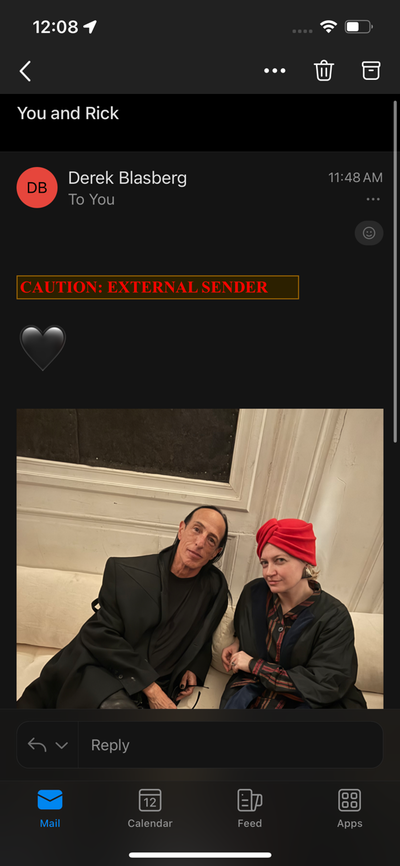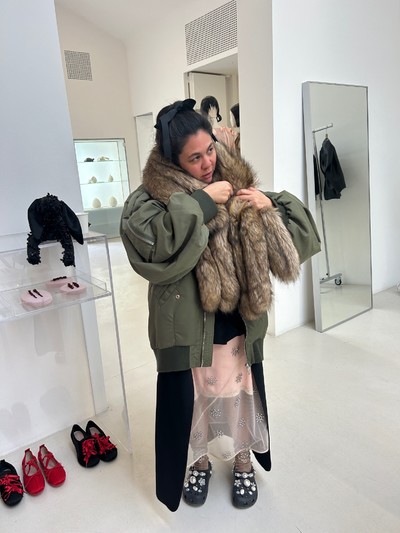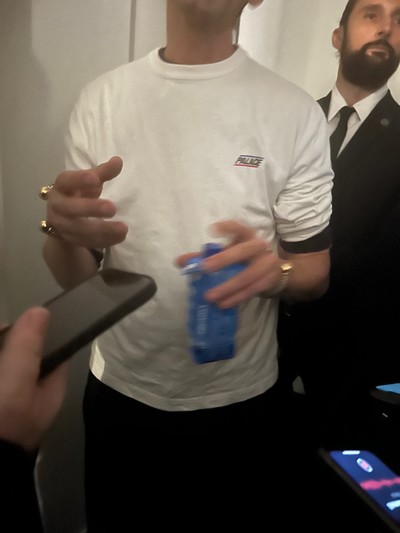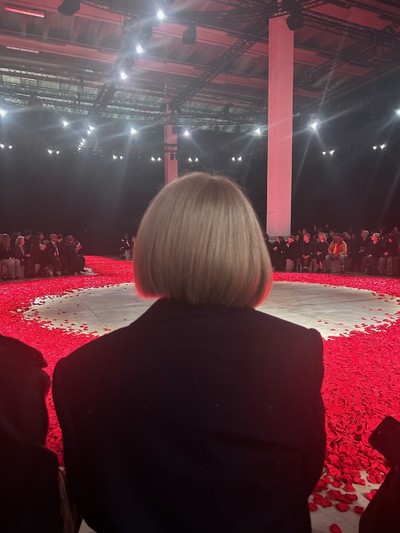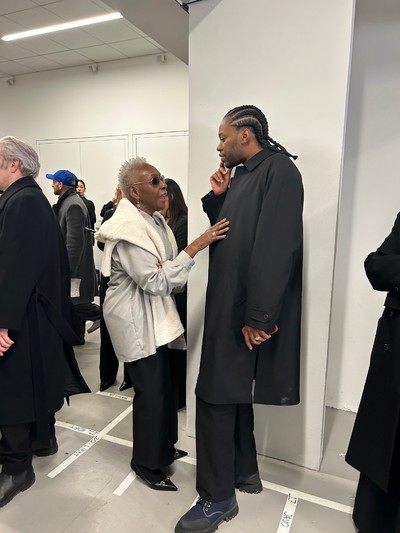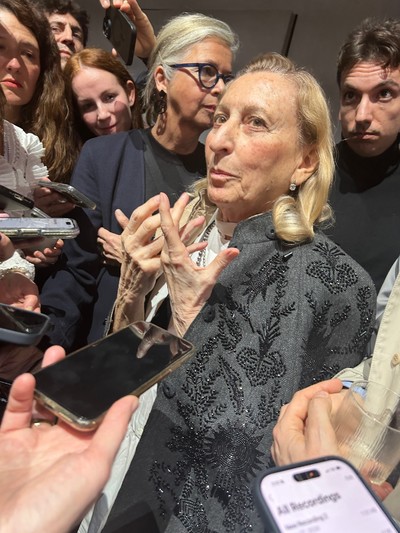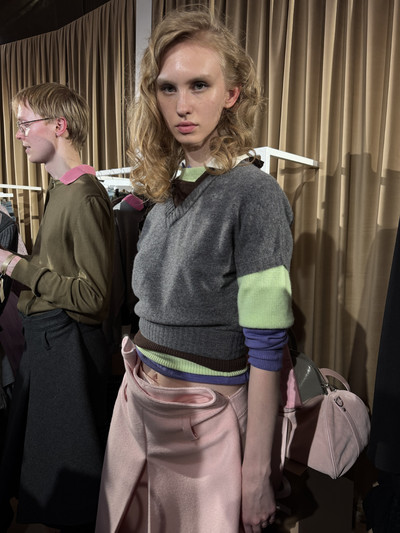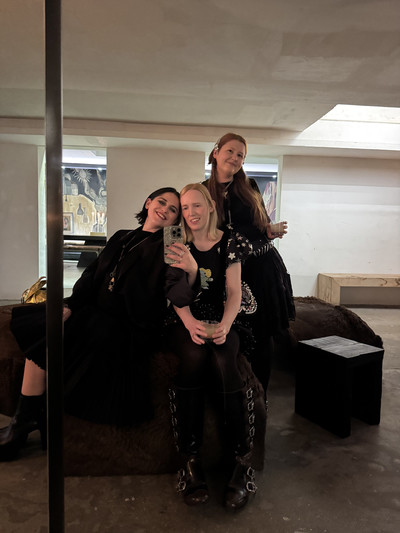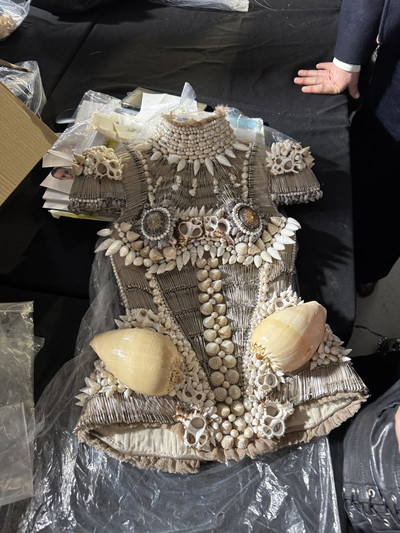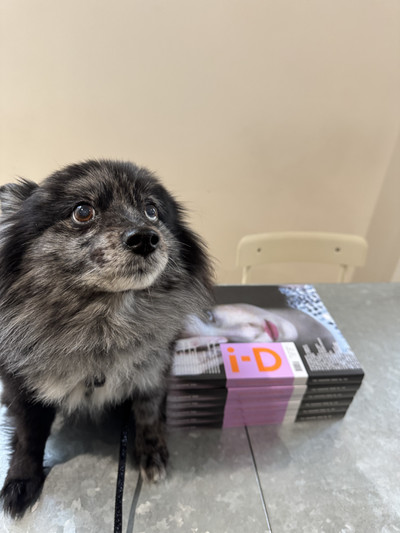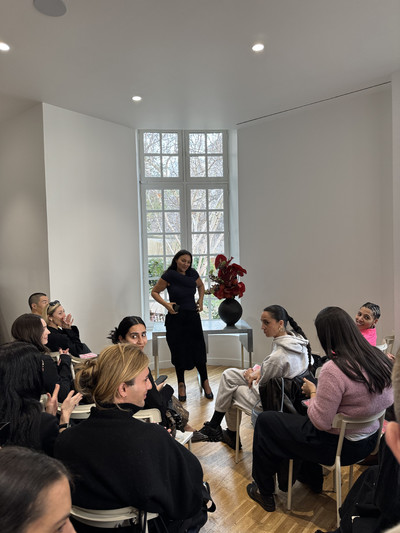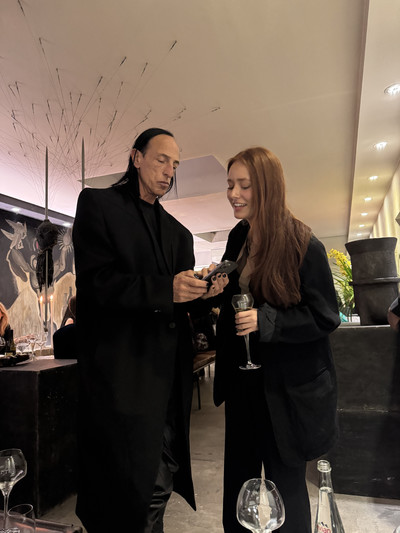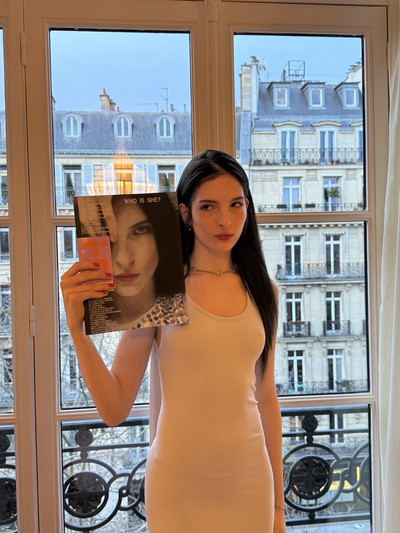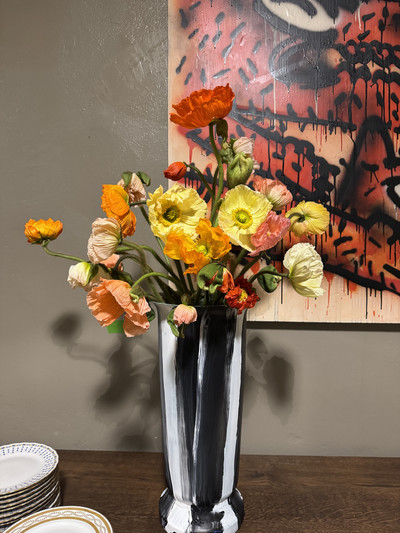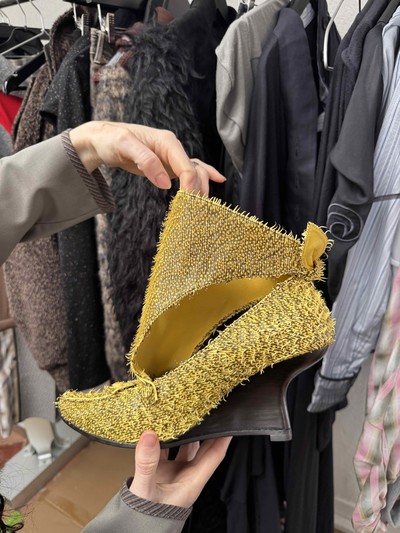Interview by Emilia Petrarca
‘I can’t wait to see the influencers
wear the bullet bra.’
There are no two people whose fashion week dispatches I follow more closely than Rachel Tashjian and Steff Yotka. Tashjian is the fashion critic at the Washington Post. You might also know her byline from when she wrote much-shared fashion commentary and analysis for GQ and Harper’s Bazaar, or from her pioneering, ‘invite-only’ newsletter, Opulent Tips, which has gained a cult following since it launched in 2020, notably, not on Substack. Yotka, the former global director of social media for Vogue and Vogue Runway, who cut her teeth writing thoughtful reviews on countless collections, did a stint as the head of content at Ssense before joining i-D as its global editorial director in November 2024. Both currently hold very different roles and are each thriving in their lane, but together, they are always one step ahead. I turn to them for fresh, contemporary takes on fashion and shopping, as well as deeply researched reflection. They know their history, but they’re also always seeing what others aren’t – what’s new and who’s next; what we want now and why we want it. As I’ve gotten to know them personally over the years, I’ve also come to admire their unwavering enthusiasm and dedication to what they do. Spread out comfortably on Tashjian’s couch in New York, we could have talked late into the night about the Autumn/Winter 2025 collections, but here is one and a half hours’ worth of passionate, laugh-filled discussion. Reliving the month through their eyes was thrilling.
Emilia Petrarca: I feel like we should start with the fact that, right before this interview, all three of us ended up at the 6397 showroom in SoHo for a press appointment to see the new collections, at the same time, without planning it. What made you guys go to 6397 today?
Steff Yotka: I have known [founder] Stella Ishii for over a decade at this point, because I reviewed the 6397 collections for Vogue Runway. The brand is the secret hero of my closet – it’s the only ‘elevated basics’ that I own. I’m probably wearing something from 6397 almost every day. So I had to see what clothes I’ll be wearing in six months. I also think Stella is a really magical figure in fashion. Her business is so organic and thoughtful. She’s been in the fashion business for like 40 years, and she’s still as inspired and interested in new things as she always has been. Getting to have face time with someone who feels more seasoned and more experienced but still full of that sense of wonder is so important.
Rachel Tashjian: The publicist mentioned that Stella had worked with Margiela and Comme des Garçons, and that Judy [Collinson, who joined Ishii’s team last year] had worked with Barneys for such a long time. One funny thing I kept hearing this season from both people at shows and from readers was an intense nostalgia for Barneys. I think people really want to connect with clothes in a different way, aside from seeing them or reading about them, and that was a place where you could really do that. So that’s why I went.
Well, I’m really honoured and excited that you asked me to moderate this conversation. Could you describe for me very broadly what the mood was this season? Not so much in terms of the clothes, more the atmosphere. It seemed like a moment of uncertainty, with all these changes happening at the houses, but also in the world at large. Was it weird?
Steff: I think it did feel like an in-between season in that there was no single collection or cluster of collections that everyone universally agreed was fabulous or important. Sometimes, it’s a really small independent brand, like ALL–IN last season. Everyone was excited about it. But this season, there wasn’t one thing that everyone glommed onto in any city. It didn’t congeal into one big point.
Rachel: It was ambivalent.
Steff: Yeah, it was very ambivalent. And with smaller budgets and looming recessions or financial instability, you could really feel that people were thinking about that at the brand level. The spectacles weren’t as spectacular as they had been six months ago, or a year ago, or two years ago.
Rachel: It was really interesting how much smaller the shows were in terms of the audience size. I don’t know if this is true, but the Miu Miu show felt like it was half the size that it usually is. Louis Vuitton did a really, really small show. In the fashion industry, you never know why those things are happening. You get double-speak from brands and various publicists. Is it a budget thing, or is it an exclusivity thing?
Steff: I don’t know why these changes were happening, but you could see across almost every brand, big or small, that they were trying to cultivate a new feeling in the room. There were still shows that were spectacular – the Dior set clearly took bajillions of dollars and millions of meetings to come to fruition. But every brand was striving for a new sensation. Some came together nicely; others, you couldn’t make heads or tails of. But everyone was trying to find a new playbook. The Virgil-Alessandro-Demna spectacle of celebrities, memeable clothes on the runway, and crazy accessories is very over.
It sounds like it was a little squirmy or unsettled.
Steff: Fashion people are very uncomfortable with change, because it makes everyone question their place in the industry. If shows are changing their seating, or things are happening on different days, or some shows are bigger, or some shows are smaller, suddenly you’re left fending for yourself.
‘The Virgil-Alessandro-Demna spectacle of celebrities on the front row, memeable clothes on the runway, and crazy accessories is very over.’
Speaking of seating, I want to hear more about The Row show.
Rachel and Steff in unison: Oooohhhh!
But! Before we get there, I feel like in these moments of squirminess, it can be useful to ask the most basic questions. I wanted to ask each of you: what is your job? Not your literal job description, but how you would describe it. What do you do?
Rachel: I rethink it every season. Beforehand, I’m thinking about the debuts, or someone who had a great season last season, or someone who I know has made some kind of personnel changes, or stylist changes, or something like that. I look at what is to come, and I think about what the possible narratives might be, and how I want to approach them. This season and the one previous, my readers and I were thinking about quality, design, the purpose of beauty, and how to find good and interesting clothing. So this season, I had this project in the back of my mind that was percolating the whole time: I’m going to go to the showrooms of designers who do not do shows, either because they can’t afford to or they’re not interested, and talk to them and see what their relationship is to fashion and their customers. The Washington Post reader should know who Sofie D’Hoore is, and may not necessarily care about Dior.
Steff: Starting a new job, I’ve really tried to think about why we’re doing this. At its heart, i-D is a culture magazine. It’s been so involved in the fashion industry from the start – Terry [Jones, its founder] worked at British Vogue as a creative director and art director – but it has to be about how fashion bleeds into other arenas. All of us and our friends, the way we talk about Alaïa and the way that show really gets your heart rate going, is, to me, an analogous experience to going to a concert where you don’t know the band, and so every song is new, and you’re excited and into it. I want to capture the emotions that you feel at fashion week and try to give that to our audience. We’re a ‘youth culture’ magazine, but I think that’s also about a state of mind. We have readers who are 70, and we have readers who are 17, and I think every person wants to feel something when they look at a fashion show or feel something when they read an article. We don’t do hard-hitting news reporting. So you should come to i-D to read something interesting that makes you rethink something about music, culture, politics, fashion, art, whatever…
Rachel: …being a girl.
Steff: Being a girl! So I have one eye on the fashion shows, and the other eye on everything else: Where people are eating, which DJs are playing, which interesting people are coming to town? How are they dressing? Where are people hanging out? What areas of the city are cool? We want to have an anthropological lens on fashion week.
Rachel: The main characters at fashion week are always more interesting than the celebrities. There’s always a new main character every season. Dara [Allen, stylist and fashion editor at Interview] was the main character a year ago.
‘Celebrities have never looked worse, and I really want them to look better, because I think that’s how we shape a lot of our perspectives on beauty.’
And what do you think a designer’s job is these days?
Rachel: Speaking of the ambivalence this season, designers are asking that question. It came up a lot backstage. Either they would answer the question without having been asked, like Mrs. Prada and Raf, immediately, before anyone started asking questions, said something to the effect of: ‘It’s a very difficult moment, and so we’re working very, very seriously.’ I loved that. I wrote it down in my journal. And then you had other designers, like Pieter Mulier, who spoke backstage about wanting to reference and meld different cultures together without making it clear where the references were coming from; he just wanted it to feel new and different, but also somehow relatable and globalized. But, yeah, it does seem like many designers don’t really know what their purpose is. At this moment, it’s so complicated knowing the answer to that question, whether it’s ‘I design real clothes for real women,’ or ‘I design clothes that are a solution for your wardrobe,’ like the designers we saw today at 6397. Or, ‘I provide escapism.’ Those are interesting and important answers… It’s funny, I’m ironically doing what I’m accusing designers of doing. But I do think the answer is that a designer’s job is to know what their role is – to know what they want to say and what their place in culture or a person’s wardrobe is.
Steff: I agree. The best designers, whether they’re operating on a billion-dollar business scale or a million-dollar one, have to have an idea of what they believe in and be able to communicate it to an audience. We saw a lot of shows that were short on ideas, short on the point. I always think that ‘we’re dressing a modern woman’ is a bit of a cop out. Like, that can’t be the raison d’être of a collection. Because, of course. That’s the point of fashion week. Like, duh. The best designers are convinced by their ideas and can convince us, too. Whether their ideas are beautiful like Alaïa or sinister like Demna. Hillary Taymour of Collina Strada is usually so optimistic, but even she was like, ‘The moment is weird.’ She was willing to say it, whereas a lot of people are hiding. It felt like a season where people were just keeping their heads down and trying to move forward.
Rachel: You know who I thought was really intentional, too? Armani. There’s a difference between someone who’s on autopilot and someone who has total authority. The former is like, ‘I’ve done this forever, and we’re coasting. We’re a cruise ship. We can hit the button and put our feet up.’ But the latter knows exactly what their customer needs now, and can give it to them, and it’s not exactly what they thought they would see; it’s even more beautiful.
I got the sense that designers are being given the directive: ‘Make clothes that make money.’ But, as you wrote, Rachel, does anyone actually want this stuff? It can all feel a little pointless sometimes. But let’s get deeper into it, starting with The Row. Please, someone set the scene. I’m dying to know what it was like in the room.
Rachel: I mean, it was the greatest fashion theatre. We were each assigned a room, but they were like, ‘Sit wherever.’ A couple of people had chairs saved for them. There were these two women seated on a couch – Emilia, you would have lost your mind over this – with a Margaux bag taking up a seat in between them. It was unclear who these two women were. They were really beautiful. I thought they were maybe VICs or something. People would ask, ‘Can I sit there?’ And they would say, ‘No, no, sorry.’
This is like performance art.
Rachel: And then it became clear that they were saving the seat for Anna [Wintour].
Oh my God. Was there confusion pre-show? Were you like, ‘What am I walking into?’
Rachel: Usually, it’s a very small show. So, you walk in and someone says, ‘Oh, hi, Steff, you’re over here.’ But I was in the car with the Harper’s Bazaar team, and suddenly, someone looked at their texts and said, ‘It’s not assigned seating!’ And we ran in. There weren’t enough chairs for everyone.
Do you think they did that on purpose?
Rachel and Steff in unison: Yes.
Rachel: Editors-in-chief and very senior people tend to come in closer to the start of the show, so a couple of them started sitting on the floor. Lindsay Peoples sat on the floor. Sara Moonves sat on the floor. And then it was suddenly like, ‘Oh my God, all the cool people are sitting on the floor!’ I wrote in my review that this is how The Row works. You’re like, ‘that’s not quite right,’ or ‘that’s not interesting.’ And then someone who’s really chic wears the jelly shoe, and you’re like, ‘No, actually, these are incredibly sick.’
Steff: Exactly. This was my first The Row show, ever, and talk about cultivating a vibe in the room… It disarmed everyone, and created a sense of conviviality in the space where we were all kind of like, hehe. Mel Ottenberg was across from me, sitting on the floor in his jeans, looking hot and fabulous. It made watching the show so much more enjoyable, because I think how you watch a fashion show informs what you think about it. I remember at the last Dries [Van Noten] show, we were all sitting in a row. Me, Emilia, Sam [Hine], Willa [Bennett], and José [Criales-Unzueta], and it felt like such a beautiful moment. We all started doing this or obsessing over this when we were teenagers, and now we’re at this show – the last show of this legend – and gold foil or whatever is floating through the air, and David Bowie is playing. After the show, Sam and I had a beer, and we’re watching the disco ball with tears in our eyes, like, ‘It’s happening for us.’ And The Row created this slightly mischievous, gossipy energy during the show. It felt OK to lean over on the couch and say, ‘I love that look.’ Usually, I try to be quiet at shows, but there was this high school hangout spirit, which gave a nice energy to the clothes, too.
Rachel: It’s funny how The Row is, in some ways, a reduced and quiet brand. Emilia, I think you once wrote about how their magazine ad campaigns were just ‘THE ROW’ written on a white piece of paper. But when they do speak, they really say something. The fact that the seating was this really casual thing, and none of the models were wearing shoes, and some of the looks were just a jacket and ribbed tights, or a really simple dress with a beautiful roll at the sleeve – it was really easy and soigné. And then they always give out food after the show. They were giving out madeleines for a while. This was also when they were doing a lot of vintage Romeo Gigli and Issey Miyake references, and it was very Proustian to me – these memories of fashion past. This time they gave out club sandwiches and bone broth, which was very nourishing and very…
Steff: American. There was no vegetarian option. As someone who doesn’t eat meat, I left hungry. But the sandwiches got really good reviews.
It doesn’t sound over-explained. You guys came away from this experience and could fill in the blanks, and that’s so much more satisfying. They didn’t need to write it out in a heady press release; it’s more subtle.
Steff: There’s something really freeing about going to a show where the designers are completely in control. Ashley and Mary-Kate own this brand. They’re beholden to no one, right? They can choose to show whatever they want. If they’re like, ‘We don’t like shoes this season,’ they’re just not going to have shoes. It’s gratifying as a viewer to see something where you don’t leave questioning, ‘Was the marketing budget slashed?’ Or, ‘Did they change the sound designer?’ The longer you do this, the more you start to understand the behind-the-scenes machinations, and at The Row, you’re seeing the purest creative expression of their interests and their design teams’ interests. There are very few shows where you feel like that’s the case.
Rachel: What else did you like in Paris?
Steff: Hmm. Well, I loved Miu Miu. I thought it was very Rachel-coded, which I texted you during the show. Intelligent, sexy women in weird hats? I know one of them.
Rachel: I thought that show was one of Mrs. Prada’s strongest shows since the Miu Miu-aissance.
Steff: I thought it was a very clever step away from the teenage sexiness that they had been exploring for the past couple of seasons, since the infamous midriff collection. There’s always a girlishness, but this was an adult’s wardrobe done in a fucked up way.
Rachel: I can’t wait to see the influencers wear the bullet bra.
‘As a person who wears unflattering clothing, when I saw the Prada show I was like, ‘I’ve won the lottery.’ Miuccia and Raf are endorsing slobbishness.’
I’m curious to talk about the Miu Miu show in conversation with Prada, because they seemed so different, but there were obviously similar notes. I really struggled with the Prada show. I got it on an intellectual level – and I’m down with the idea of offering something generally considered unflattering. But I’m a Prada shopper, and looking at the photos, I was like, ‘I don’t want any of this.’ Not only that, ‘I would look bad in it.’ And I’m pretty confident that it would be hard for most people who aren’t models to pull it off. The point is that it wasn’t flattering, and I get it. But I was frustrated because I felt like my two options this season were: Be a pretty Chloé woman or a hot mess. I’m neither of those people. So, what do I do?
Rachel: Did either of you notice that people went really wild for the Phoebe [Philo] stuff this season?
The Phoebe pitch was higher than ever.
Rachel: I wonder if that was a reaction to what you’re saying, because I previewed the drop before it came out, and afterward I was like, ‘I need to throw out everything I own.’ It really answered all of these questions. It’s not a hot mess; it’s very strong.
Steff: Yes, but it’s still slightly silly. What does that pin say?
‘Semi Rough.’ She has a sense of humour, which I’m not sure Prada did.
Steff: As a person who wears unflattering clothing, when I saw the Prada show, I was like, ‘I’ve won the lottery.’ Miuccia and Raf have finally given up on traditional beauty and are endorsing slobbishness, which I think many people had a very visceral reaction against, because ultimately, being beautiful is still such a driving force in getting dressed. I was so convinced by the red knit 1960s dress worn with a button-down shirt underneath and over jeans, I thought I was going to run out of the re-see with that mannequin. It’s disgusting in a way that is going to make everyone who sees it have this icky, visceral reaction, and I really liked that sensibility. I don’t know if it’s just because I just got back to America four days ago, but it feels very anti-Trump to make clothes that are so obviously ugly. There’s this really traditional sense of beauty that is becoming a dominant trend in the US…
Rachel: It’s extremely Barbie glam.
Steff: To make something that is so luxurious yet frumpy feels like a radical, total opposite. It was invigorating to me. In a weird way, I felt like the Prada show had some commonality with what Bryn [Taubensee] and Patric [DiCaprio] are always dancing around at Vaquera: They make clothes that are ill-fitting on purpose, and give you this oversized or shrunken or demented sense of proportion. It’s also very Comme des Garçons. That’s always been very liberating for people trying to find a new aesthetic. It’s interesting to see Prada getting to this place because it has always been glamorous. Even the ‘ugly-pretty’ Prada shows are still glam and so beautiful. But it finally tipped more into ugly, and I loved it, but I understand…
No, no, you’re convincing me.
Rachel: You brought up glamour – wasn’t that the collection’s name? I had already sensed that glamour was a theme for a lot of the designers in New York, and maybe London as well. They’re grappling with how to offer an alternative, either aesthetically or intellectually, to this very hyper-feminine, hyper-traditional glamour that we’re seeing in the United States. Tory Burch’s collection, for example, was really effective for that reason, because it looked very modern. It was easy and it was sexy, but it also had a bit of archness to it.
Steff: I also thought Altuzarra had a lot of good answers to that question. Joseph makes a pretty dress prettier than anyone else, but there was so much strangeness in that collection, with those big feathery hats, tubular, chunky skirts, and different silhouettes that I thought, ‘Oh, if you’re a designer who has built a customer that is a society woman who is going to galas, or who is on the boards of museums, and she feels the need to differentiate herself from other women who are more ‘American glamour’, these are amazing options.’ The clothes felt smarter and sneakier.
You’re making me rethink the definition of ‘flattering’. I do think people who wear Vaquera and Comme look amazing, and they could in the new Prada collection, too.
Rachel: Remember when Rihanna wore that enormous Vaquera diaper or something, and we were all like, ‘She looks so hot!’
I’m curious to see how that Prada collection looks in stores.
Rachel: I’m also very curious what those dresses will look like in the store, because Emilia, they looked so bad on the mannequins at the re-see. It was like a John Waters housewife fell asleep on her La-Z-Boy and lit her polyester dress on fire with a cigarette.
[Sighs] Yeah, that’s cool. I guess.
Rachel: I kept thinking at the re-see: ‘Who is this woman?’ I thought about it at the Calvin Klein show, too. ‘Where am I encountering her?’ I imagined a woman trying to sell a $2 million painting at Frieze, and she’s wearing this dress, and I’m like, ‘OK, she gets something that I just don’t understand, and so I’m totally buying this $2 million painting from her.’ The ugliness becomes alienating, and therefore convinces me that I am not the expert.
‘I think this season introduced that question: ‘Do you have to have a show to be relevant?’ And if you have a show, what must you provide the audience?’
Are there any collections that you’ve changed your mind about since you first saw them?
Steff: Rachel and I had very different knee-jerk reactions to the Tom Ford show. Rachel was there, and I wasn’t. I watched as the pictures came in on the Vogue Runway app – without context, without the press release, without the music, without being in the space – and I remember texting her and saying, ‘It looks like a Haider [Ackermann] collection. It’s very chic. But I feel nothing for this.’ When you explained the show to me – the show notes, the way the models walked, and how Haider came out and gave Tom Ford this intimate embrace – my point of view on the collection changed.
Rachel: I can get swept away by shows, but I’m also super tethered to reality. I’ve never had the experience of being like, ‘this is the most amazing thing,’ and then changed my mind. When I feel something blowing my mind, I’m always like, ‘is it really blowing your mind? Keep your cool.’ So with Tom Ford, I was like, ‘This is pretty extravagant. It’s pretty amazing.’ But I was also thinking, ‘if you’re not here, will it hit you?’
Oh, it hit me, and I was also scrolling Vogue Runway. It just felt so sexy and very Hollywood in a way that made me realize how much I’d been missing that.
Rachel: That’s an important point. Celebrities have never looked worse, and I really want them to look better, because I think that’s how we shape a lot of our perspectives and our standards on beauty. I was very hopeful that there would be beautiful suits and great gowns – gorgeous, gorgeous gowns – and there were, and they were very different, but they were accessible. It reminds me of Adrian’s costumes, where Greta Garbo walks in, and you’re like, ‘that is so bizarre, but you are fantastic and otherworldly.’
What else did you love?
Rachel: The show of the season was Duran Lantink.
I’m glad you brought him up because I was at home being like, what?
Rachel: The show blew my mind. It made me laugh. It made me excited about the future. With all of the nostalgia in fashion, people ask, ‘Why is this happening?’ But the future looks terrifying right now. If you think about it, in the 1950s, when the future was imagined with flying cars, the Jetsons, and progress, it was exciting. There’s nothing like that at this moment. Every vision of the future is dystopian, and so for Duran – or Kiko [Kostadinov], Laura and Deanna [Fanning], who are also committed modernists – to show you something that you’ve never seen before, even when it’s not always working, it’s electrifying.
Steff: It’s electrifying. We were giggling as we left the Duran show. It was so convincing. The clothes have such a physicality to them – the way they look from every angle is completely different, and that can’t be captured in a single image. Half of the looks are completely backless; the models had their entire ass out. Two models just wore body paint and underpants. Every time a model came out, I had no idea what they were going to be wearing or how it was going to make me feel. It’s so exciting to see a young designer that committed to the expression of what they believe in.
Rachel: Backstage, Duran was not necessarily able to explain what he was doing, and I actually find that really cool. He said it was important for him to design from a very free space, which, first of all, I really like that, because freedom is something that is a huge cultural lightning rod at this moment. Not that he was thinking about the United States, but there are a lot of people on both sides of the political spectrum in the United States who feel like their freedoms are being impinged upon. So to say, ‘I’m coming from a place of freedom in my creation,’ is really cool. On top of that, Megyn Kelly discussed the show on her podcast. She was upset by it because there was a male-presenting model wearing fake breasts. She was like, ‘This is what the elites in Europe are trying to convince you that you should be wearing.’ I thought, ‘God, she’s fallen right into his trap.’ It was a great example of how in this season where you have all of this ambivalence at the big houses – even at Valentino, where there’s a feeling that Alessandro [Michele] isn’t that into what he’s doing – at least there are smaller designers, new designers, who can come in and grab the attention.
‘Duran’s clothes have such a physicality to them – the way they look from every angle is completely different, and can’t be captured in a single image.’
This show was funny to me because suddenly, everyone I follow who was in Paris was excited about this name I’ve never heard of, talking about him like they’ve known him their entire lives. So I tried to learn more, and I see all the headlines about the boobs. But then it seemed like the show got too much press, and fashion people were, like, ‘just kidding, it’s overhyped, it’s gimmicky.’ I couldn’t get a read on it. Sounds like you guys are still down, though?
Rachel: From my perspective, he used the two viral body stockings as bookends to get people to look at the collection. But then the rest of the collection was amazing.
Steff: His whole design language is about pushing your body into new forms. If you go back and look at previous collections, the clothes grow around the models like tumours. So, in that way, Mica [Argañaraz] with the eight-pack abs, and the male model with the breasts felt like another way to push your body into a new dimension – maybe the most obvious way, but it became the most upsetting. It’s interesting to me that for years, he’s made clothes that are also kind of ugly and unwearable, and everyone was so into it, but the second he made something that looked slightly more human, it became like a hot-button issue. It says a lot about how we see our bodies and attractiveness.
Speaking of bods, should we circle back to Calvin Klein?
Steff: Let’s talk about Calvin Klein, because I’ve never felt more devotion to an ad campaign.
Oh my God, I watched the Bad Bunny video so many times.
Steff: Me too. When he says, ‘The vibe is infinite.’
Rachel: Did you see Mel’s photo of people kneeling before the billboard?
Steff: Yes, I was like, ‘I want to be there.’ Take me to the prayer session at the Bad Bunny billboard on Houston Street. As someone who worked in the marketing department at a retailer and was constantly tasked – on a way smaller scale, because Ssense is independent and Canadian – with rethinking how we present our products to our audience, it consistently blows my mind that Calvin Klein has an unimpeachable formula of hot people in their underpants, and they still do it better than anyone. You’d think that other brands would be able to do this, and Calvin Klein would have to do something else, or that they’d be choosing the wrong hot people, or their campaigns wouldn’t work, yet somehow it is always the most incredible. Last year, when they had Jeremy Allen White, it broke people’s brains to see him on that couch. And now Bad Bunny has us on our knees, and he’s just wearing underpants. I don’t know who took the pictures. It’s just about the sheer power of the hottest, most famous, compelling person being nearly naked, and in contrast to the fashion show, I just was like, what?
Rachel: The fashion show was clearly trying to speak to a sophisticated, well-off American woman who’s a little bit of an intellectual. I wrote this piece about ‘Rowdent’ brands, or brands that emulate The Row, and it was partly inspired by that show. Everyone is after that woman right now, in part because a lot of women are like, ‘Ah, how do I have a personality?!’ That seems to be a big obsession on Substack – not in yours, Emilia – but everyone’s asking: ‘How do I indicate to people that I have a rich inner life through clothes?’ There were moments of beauty in that show, and there were certainly wonderful fabrics, but a lot of people responded to it somewhat coldly. And then this ad campaign comes out with Bad Bunny, and every brilliant, creative, intellectual woman I know is texting each other, ‘This is the hottest thing I’ve ever seen.’ It’s interesting that that is what that woman actually responds to.
Steff: There were a couple of looks I liked. One was sort of orangey, and another had lilac jeans with a tight gingham or flannel shirt, maybe with a sweater over it. They were my favourites because they still have that kind of sexy, crisp Americanness. It’s an important time for a brand like Calvin Klein – our most American brand, aside from Ralph Lauren – to do something subversive and American and sexy and free. The clothes at the show were beautiful, but they did feel very indebted to a European sense of design and beauty, especially an Italian sense of tailoring, materiality, and tastefulness.
I feel like I can say this: it was so Italian to me. When I read the interview that the designer did with Vanessa Friedman, where she called it ‘sextitude’…
Rachel: That’s a Dolce & Gabbana word.
As soon as I read that, I was like, ‘this will not go well.’
Rachel: I’ve long thought that Eckhaus Latta has a Calvin vibe, or they have an American sportswear vibe, and I felt like that show answered the questions that Calvin Klein should be right now.
Steff: I thought this was one of Mike [Eckhaus] and Zoe [Latta]’s best shows.
Rachel: I think it might be their best show ever.
Steff: It was so simple, but so sexy in its simplicity. There were no frills in this collection. And I think we’re living in a moment where something simple and comprehensible and hot is really desirable. The girlhood moment of coquette-core and the maximalism that came right after the pandemic is going out of style to favour a smarter, kinkier minimalism that you see in Phoebe’s collection. I think Mike and Zoe really hit the bullseye. Those leather pants that they made with Ecco look fucked up in the right way. I left that show feeling like I should dress like a normal woman, and I’ve never felt that way.
Rachel: I also thought there was a political undertone to that show. They didn’t say this, but the attitude I got from the show was: ‘You guys are doing your weird stuff in Washington, and we’re here in New York making art, making music, making clothes, hanging out with our friends, smoking weed…’ They did a bong collab, right? Like, ‘we’re protecting our people, and what you guys are doing is horrible.’ It reminded me a little bit of the attitude fashion designers had in the 1970s. I’ve been looking at old Zoran shows so much, and he used to show in his loft. Lauren Hutton was there – she’d just come from the grocery store. She’s got her bag, and she’s yucking it up with Bill Cunningham. It felt like that.
‘Rachel told me about the experience of buying shoes at the Prada store next to the Duomo, and how the salesperson was so Miuccia-esque.’
Steff, what was your experience in London like this season? You’ve always been such a champion of young British designers, and of course i-D is also based there.
Steff: I love going there, and I’m always really inspired when I’m there. So I’m shocked when people say they don’t enjoy it, and by Imran [Amed]’s BoF piece about how London and New York Fashion Week should only be once a year. People were enraged by this, and I am also slightly enraged by it. I understand from a business perspective that it takes a lot of money to put on a fashion show, but to me, London is the most exciting fashion week because you can go completely off-calendar and find cool designers everywhere. Dilara [Fındıkoglu]’s show this season was a real triumph. She shows once a year, or maybe every other year, and she came in with a bang. The clothes were impeccably made. The ideas about femininity and freedom and sexuality and sensuality were so fully realized, and done in such a contemporary way, and she’s so fearless in how she designs. She will put a naked model on the runway, just with hair. She’s not compromising, in the way that Duran will put a guy in boobs. The ambience is always right in the room. The casting is always right. There’s a feral energy, like anything could happen. A model could smack me across the face, and I would love it! I also thought it was a beautiful show of confidence. When Sarah Burton left McQueen and they hadn’t named her successor, the online fashion community was really gunning for Dilara to have this or that job. Many independent designers can feel very scorned when they’re not approached by mega brands. And I think this was the ultimate: ‘You don’t want me? Well, I don’t need you.’ She didn’t say this backstage, but for those of us who have been following her career you could read between the lines. It was a provocative fuck-you energy that Lee McQueen was so known for, but coming out through a young woman today. She has that spirit of: ‘I do this my way. I’m uncompromising in what I stand for. I understand history, but I also understand contemporary life, and I’m just going for it, full throttle.’ Designers are so often defeated. I understand it’s so hard and thankless, but to see her come back with such grace and vitriol at the same time, and how it manifested in such a beautiful way, I was taken aback. I thought it was outstanding, and I wish that more people were in London to see it.
Rachel: It’s frustrating when you’re trying to follow from afar. I want to read a really great story about Conner Ives. I want to hear what’s going on with Toga. Why is that so good all of a sudden?
Steff: I also loved Jawara Alleyne. Stefan Cooke hosted a pop-up instead of a show, and people were shopping. The Paolo Carzana show was in a pub, and it was incredible. London has such an important energy. On the one hand, you hate to see brands leave. Kiko, for example, whose shows we’ve both really enjoyed, basically moved its whole operation to Paris, partially because of Brexit, but also because more people are there, so more people will see their clothes. It’s great to see an independent brand have such a successful accessories business. One of my colleagues said that he owns seven Trivia bags. If I were a headhunter at a mega brand, I would be like, ‘Well, these two young women clearly know what other women want, and we must hire them.’
‘Calvin Klein’s unimpeachable formula of hot people in their underpants consistenly blows my mind. I’ve never felt more devotion to an ad campaign.’
OK, lightning round. Best meal you had?
Steff: My favourite meal was the lunch you, me, Nicole [Fritton], and Lynette [Nylander] had before Dries Van Noten. It was a perfectly portioned sushi lunch.
Rachel: That was my runner-up. I had a morning where I saw Margaret Howell, and then Duran, so I was riding high. Then we had a horrible lunch.
Steff: Yes, the worst salad and Coke Zero experience of our lives.
Rachel: Then I went to the Valentino show, which I really did not like, and then I went to the Balenciaga show, which I found very depressing. So, I was like, ‘I need to go out and find the most extravagant, bizarre food that I can.’ And I ate a chicken gizzard salad.
Steff: I would also enter the vegetable soup and a martini we had at Rick Owens’ house.
The best thing you bought while you were gone?
Rachel: I got some great shoes at Prada.
Steff: And so did I. Rachel told me about the experience of buying them at the Prada store next to the Duomo, and how the salesperson was so Miuccia-esque, and gave her all these styling recommendations. So then we went together the next day to buy the shoes, and it was a comedy of errors: they didn’t have them in my size, and they didn’t have the press discount. So, I ultimately bought them in Paris.
Rachel: I got the re-editions of the sandals from the ugly-chic collection from 1996 that are big, black, shiny leather with a tortoise buckle.
Steff: I got the loafers from the current season with this big, metal door knocker on them. They really are so powerful.
Did you cry at any point this season?
Steff: I definitely cried. One time was at Bottega’s ‘Intermezzo’ performance – one of the best things a fashion brand could ever decide to do. Put this on the record: rather than having a studio show or a presentation, they presented us with the most powerful, bone-shaking performance by Patti Smith. She performed the song ‘Because the Night’ and everyone in the audience was singing, and at one point, she stopped to cough, but it didn’t matter, because all of us were singing, so the song kept going. It was exquisite. No one can command a room like Patti Smith. It was a very small crowd, and very hot, but very transformative.
Rachel: I’m constantly frustrated by waste in the fashion industry – waste of material, waste of energy, waste of time – and these studio collections so often feel that way. So I thought it was really beautiful and frankly, a generous and elegant thing to instead say, ‘Let’s do a performance.’ You don’t need to make stuff and have a fake thing about how there’s a fake idea.
Steff: Like you said before, fashion consumers are questioning, ‘How can I signal that I have a rich intellectual life through my clothes?’ And Bottega was just like, ‘Oh, we have that.’ Like, we have a rich intellectual life. And here’s Patti Smith. Ten years from now, when someone asks me what happened during this season, I may have forgotten all of the collections, but I will always remember Patti Smith.
‘Ten years from now, when someone asks me what happened this season, I may have forgotten all the collections, but I’ll always remember Patti Smith.’
What do you never want to see again?
Steff: The sound of a toilet flushing at a fashion show.
Rachel: I’m so tired of fake Instagram accounts and social-media posts being like, ‘I’ve heard that Hedi Slimane is going to Armani.’ People I know will send these things to me. They’re like, ‘So, is this true?’ It’s like, ‘Why do you believe this?’ It’s an issue of media literacy that really concerns me as a newspaper reporter. It’s a lot of fun, but it doesn’t add to anyone’s understanding of fashion to be trading rumours.
What are you looking forward to in September?
Steff: I’m excited about another season of change. I’m excited about Matthieu [Blazy] at Chanel. I’m so stoked to see whatever happens to Jonathan Anderson. I’ll be excited to see Glenn Martens at Margiela.
Rachel: Demna at Gucci. Proenza guys at Loewe. Louise Trotter at Bottega.
Steff: It will be an interesting season for the future of what a fashion show even is. I think this season introduced that question: ‘Do you have to have a show to be relevant?’ And if you have a show, what must you provide the audience? Should it be a spectacle? Should it be an intimate show in your atelier? Should it be sitting on the couch or sitting on the floor? In September, that conversation will continue. Condé Nast is having fashion shows now, and they’re almost dwarfing fashion week in their grandeur. The next Vogue World will take place in LA on the Paramount Pictures lot and will have historic cinema costumes integrated into it. People at home care about that so much more than what happens at fashion week.
Rachel: More than: ‘Will Sarah Burton forward the legacy of Hubert de Givenchy???’
Steff: On top of the undercurrent of all these designer debuts and industry changes is the question of: ‘Why are we even doing these things to begin with?’ When what we’re most moved by is a Patti Smith performance, and standing in Stefan Cooke’s garage, going through clothes, and having the best time. To come full circle, the three of us just stood in a showroom trying on jackets and cheering as we put on clothes by a small brand that didn’t show. So, yeah, I think the purpose of a fashion show at fashion week is definitely something that is in question.
